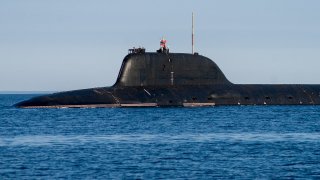Russia Wants To Build a New Fleet of Nuclear Submarines
Russia announced that eight more submarines will be produced in the coming years – including five Yasen-M and three Borei-A. However, some naval analysts have said it could be a costly move, as each of the Boeri-A class boats cost more than 650 million euros ($711 million).
Even as the Russian Navy's flagship aircraft carrier shows no signs of heading to sea anytime soon, its submarine force has seen the addition of two nuclear submarines, which were commissioned at the Sevmash Shipyard in Severodvinsk. The ceremony for the new boats was attended by Russian President Vladimir Putin.
The first of the submarines was the Project 955A Borey-A Imperator Aleksandr III (Emperor Alexander III) the fourth SSBN of the class, and the third in the Pacific Fleet. The new vessel was built by Sevmash under a May 2012 contract with its keel laid in December 2015, while it was rolled out from the shipyard hall in December 2022. Imperator Aleksandr III underwent a series of sea trials last summer and fall. However, as Naval News reported, the first three Project 955 SSBNs were different, and employed hull sections from the unfinished Project 971 Shchuka-B SSNs.
The second vessel to raise the flag on December 11, 2023, was the K-571 Krasnoyarsk, a Project 885M (08851) Yasen-M nuclear-powered attack submarine. It was the third boat from the project, and the second of its class intended for the Pacific Fleet.
The SSNs of Project 885M are a modification of the prototype K-560 Severodvinsk of Project 885, and will become the first main underwater carriers of Russia's 3M22 Tsircon hypersonic missile. In addition, the Russian SSNs of the 885/885M project can carry missiles of the Kalibr-PL system as well as the supersonic 3M55 Onyx anti-ship missiles. The cruise missile subs were developed in the late 1980s by the St. Petersburg-based Malakhit Design Bureau of Machine-Building. It was initially intended to replace the aging Akula-class nuclear-powered attack submarines.
"With such vessels and such weapons, Russia will feel that it is safe," Putin told officials and naval officers at the inauguration ceremony.
Both of the newly commissioned submarines are expected to serve with the Russian Navy's Pacific Fleet.
The Sevmash shipyard is currently constructing three more Borey-A SSBNs, which had been due to be launched by the end of last year for the Russian Navy but failed to meet the deadline.
More Russian Submarines: A Costly Move?
Putin also announced that eight more submarines will be produced in the coming years – including five Yasen-M and three Borei-A. However, some naval analysts have said it could be a costly move, as each of the Boeri-A class boats cost more than 650 million euros ($711 million).

"The submarines will come at the expense of resources allocated to other branches of the military," Jeff Hawn, a specialist in Russian military matters and an external consultant for the New Lines Institute, an American geopolitical research firm, told France24.com.
However, other experts have suggested that Putin can ill afford to abandon his maritime modernization program, regardless of its cost.
"Vladimir Putin has constantly repeated that the West represents a threat, and he must now prove to his public that he is taking the necessary measures to defend Russia," added Sim Tack, a military analyst for Force Analysis, a conflict monitoring company.
Russia's Submarines: Ready for Cold War Operations
The Russian Navy's submariners will also be engaging in training for a new "cold war," one that literally involves operations under the Arctic Sea ice.
According to a report from The Barents Observer on Wednesday, citing an announcement from the Russian Navy's Northern Fleet, nuclear submarine crews will undergo both theoretical and practical training and special attention will be given to under-ice operations of the strategic subs.

The exercise "confirms the capacity of the strategic nuclear naval forces to resolve problems from any part of the Arctic," read the fleet's statement.
The Russian Navy has long conducted comprehensive under-ice Arctic operations, but it is now renewing its focus on the waters to its north. As The Barents Observer also noted, the Northern Fleet is based in Severomorsk, Kola Peninsula, and is the most powerful unit in Russia’s Navy, with a significant number of nuclear submarines, among them two strategic subs of the Borei class.
Author Experience and Expertise: Peter Suciu
Peter Suciu is a Michigan-based writer. He has contributed to more than four dozen magazines, newspapers, and websites with over 3,200 published pieces over a twenty-year career in journalism. He regularly writes about military hardware, firearms history, cybersecurity, politics, and international affairs. Peter is also a Contributing Writer for Forbes and Clearance Jobs. You can follow him on Twitter: @PeterSuciu. You can email the author: [email protected].
All images are Creative Commons.


